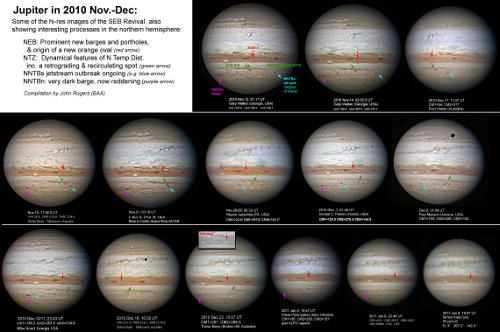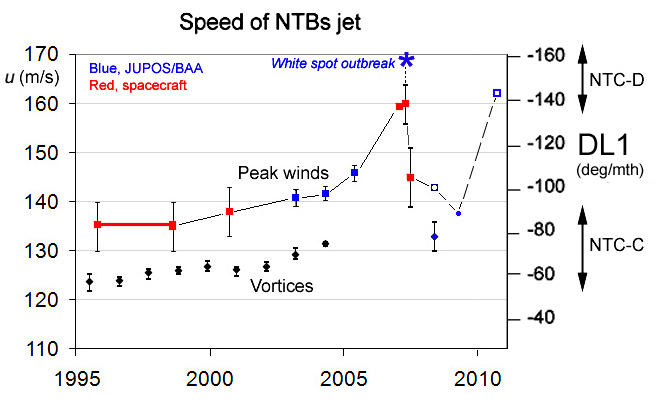
[19]
Some developments in Jupiter’s northern hemisphere (2011 Jan.13)
While all our attention has been devoted to the SEB, interesting things have continued to happen in the northern hemisphere, so here are some brief notes on them, and a set of hi-res images showing them. These images were selected from much larger compilations covering the SEB Revival, so I also have more detailed sets cropped to cover interesting spots in the NEBn and NTZ, which can be sent if required. Also, the maps posted by Marco Vedovato show the evolution of all latitudes. We will put together a more substantial report on these latitudes in the coming months. This follows on from our previous interim report: NEBn: NTBs: NTBn/NTZ: NNTBn: Appendix:
Some developments in Jupiter’s northern hemisphere
http://www.britastro.org/jupiter/2010report09.htm .
In the aftermath of the 2009 NEB broadening event, a splendid array of conspicuous ‘barges’ (cyclonic dark ovals) and ‘portholes’ (anticyclonic white ovals, AWOs) has developed around most of the NEB during 2010. The JUPOS chart showing these latitudes is attached.
Two pairs of AWOs collided, as previously reported:
http://www.britastro.org/jupiter/2010reports.htm -- reports no.9 & 11.
The first pair merged fully, but the second pair were disrupted, leaving one remnant prograding rapidly on NEBn.
In addition, there are three anticyclonic dark or reddish spots, marked ADS-1 to -3 on the chart. ADS-1 remains a tiny brown spot in a light area. ADS-2 was similar until Sep., but in its location there is now a large brown area. ADS-3 has formed more recently and is an orange oval with a darker centre, as pointed out by Trevor Barry on Dec.23. It formed in an interesting way, from the prograding remnant of the second AWO pair. In Nov. this approached a barge, where it may have interacted with tenuous light streamers retrograding around the barge, forming an eddy which became the orange oval around Dec.1. Recent images (esp. Simon Kidd’s with an IR channel) seem to show it more uniformly orange, but higher resolution is needed.
As the NEBn starts to recede, we should watch to see whether these ADSs will be left isolated in the NTropZ as Little Red Spots – something not seen since 1976.
Conditions exist for a new great outbreak on the super-fast jetstream, as in 2007: Observers should be on the alert for a brilliant white spot appearing here at any time! The southern NTB has gradually faded during 2010. Although the NTBs is quiet with no distinct features tracked, Grischa Hahn has analysed wind speeds by a new correlation algorithm that he has written, and finds that the NTBs jetstream has accelerated back up to its maximum speed, as previously recorded by spacecraft <1 year before a super-fast outbreak. Details are in an Appendix below.
The North Temperate Disturbance (NTD) is no longer particularly dark, but there are still many small spots in that sector, which also has a very dark NTB(N). Preceding it, a second NTB rifted region has developed, and this has generated at least one spot which showed all the dynamical features that we reported for the NTD in 2009.
This dark spot has been analysed by Gianluigi Adamoli. In October, it retrograded with the NTBn jetstream (DL2 = +56 deg/month), and disrupted spots on the prograding NNTBs jetstream, and then on Nov.22 it interacted with a large NNTBs spot, which swung it north into the NTZ and reversed its drift (to DL2 = -8 deg/month). (This behaviour was very similar to a spot described in our Report no.9, Fig.22.) We will watch this sector to see whether it becomes a well-established part of the NTD.
The NNTBs jetstream continues to be highly active.
There has been a very dark ‘barge’ near L2 = 240. Images in early Jan., esp. by Damian Peach, suggest it is turning red; if so, it will probably disappear soon.
NN-LRS-1 has recently been due N of the GRS (L2 ~ 160 in Dec.), and is still prograding (DL2 ~ -12 deg/month).
Possibility of a super-fast NTBs jetstream outbreak in 2011
Although all attention is now focussed on the reviving SEB, it is possible that the North Temperate Belt (NTB) could soon stage another great outbreak, as in 2007. This alert comes from analysis of the wind speeds by Grischa Hahn, who has shown that the NTBs jetstream has accelerated back to the super-fast speed that it had immediately before the 2007 outbreak.
Grischa has determined the zonal wind pattern over most of the planet, using a new correlation analysis program which he has written for WinJUPOS, and he has posted his first results (with text in German) at:
http://www.grischa-hahn.homepage.t-online.de/astro/winjupos/LongDrifts/index.htm .
After a successful test run with New Horizons images from 2007, he analysed sets of images taken 10 hours apart on 2010 Sep.4 by Don Parker and Tomoyuki Yoshida. Although this is a preliminary result, which has yet to be confirmed from other image sets, it is a very complete zonal wind profile which agrees with the previous spacecraft data and with the fastest speeds obtained from JUPOS feature tracking in 2010 on NEBs (DL1 = -78 deg/mth, u3 = +143 m/s), and SEBn (DL1 = -111 deg/mth, u3 = +159 m/s),. Therefore, it is worth noting the speed that Grischa obtained for the NTBs jetstream at 24 deg.N: u3 = +162 m/s.
A similar very rapid speed was also recorded in images from Voyager in 1979, and from New Horizons in 2007 Jan. Super-fast outbreaks with similar speed followed after one year in 1980, and after 2 months in 2007. The speed was much lower throughout the 1990s, as determined by HST and by the BAA: see attached chart (updated from:)
http://www.britastro.org/jupiter/2008report03.htm .
It accelerated gradually from 2003 and then rapidly before the outbreak of 2007. This chart shows that the speed collapsed rapidly during the outbreak in 2007 (HST data from Sanchez-Lavega et al.), and remained in an intermediate state in 2008 and 2009 (our tracking of isolated features), and has now accelerated back to the pre-outbreak speed. Therefore, it seems probable that another great outbreak could occur in the near future.
These super-fast outbreaks occurred every 5 years from 1970 to 1990 (assuming one during solar conjunction in 1985), and the Voyager result showed that the jet was still in its super-fast state between outbreaks. It seems probable that the jet has now returned to the same state, and the next outbreak could occur 5 years after the last (i.e. in 2012), or quite possibly earlier (in 2011). Moreover, the south half of the NTB has been fading during the past year. Observers should be on the alert for a brilliant white spot appearing at 23-24 deg.N at any time.
John H. Rogers, Ph.D.
Jupiter Section Director,
British Astronomical Association
<jhr11@cam.ac.uk>
http://www.britastro.org/jupiter/
